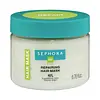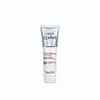What's inside
What's inside
 Key Ingredients
Key Ingredients

 Benefits
Benefits

 Concerns
Concerns

 Ingredients Side-by-side
Ingredients Side-by-side

Water
Skin ConditioningCetearyl Alcohol
EmollientStearyl Alcohol
EmollientButyrospermum Parkii Butter
Skin ConditioningOrbignya Oleifera Seed Oil
EmollientGlycerin
HumectantIsoamyl Laurate
EmollientHydroxypropyl Starch Phosphate
Behentrimonium Chloride
PreservativeErythritol
HumectantAdansonia Digitata Seed Oil
EmollientPlukenetia Volubilis Seed Oil
EmollientHydroxyacetophenone
AntioxidantParfum
MaskingSodium Benzoate
MaskingLactic Acid
Buffering1,2-Hexanediol
Skin ConditioningCaprylyl Glycol
EmollientSodium Citrate
BufferingDiethylhexyl Syringylidenemalonate
Skin ProtectingCaprylic/Capric Triglyceride
MaskingWater, Cetearyl Alcohol, Stearyl Alcohol, Butyrospermum Parkii Butter, Orbignya Oleifera Seed Oil, Glycerin, Isoamyl Laurate, Hydroxypropyl Starch Phosphate, Behentrimonium Chloride, Erythritol, Adansonia Digitata Seed Oil, Plukenetia Volubilis Seed Oil, Hydroxyacetophenone, Parfum, Sodium Benzoate, Lactic Acid, 1,2-Hexanediol, Caprylyl Glycol, Sodium Citrate, Diethylhexyl Syringylidenemalonate, Caprylic/Capric Triglyceride
Water
Skin ConditioningCetearyl Alcohol
EmollientGlycerin
HumectantBehentrimonium Chloride
PreservativeDimethicone
EmollientBis-Cetearyl Amodimethicone
Cetyl Esters
EmollientSodium Citrate
BufferingCitric Acid
BufferingIsopropyl Alcohol
SolventDicetyldimonium Chloride
EmulsifyingCoco-Betaine
CleansingHydroxypropyl Guar
Emulsion StabilisingSodium Chloride
MaskingHydroxycitronellal
PerfumingPhenoxyethanol
PreservativeSteareth-6
EmulsifyingAcetic Acid
BufferingPEG-100 Stearate
Trideceth-10
CleansingTrideceth-3
EmulsifyingTrisodium Hedta
Limonene
PerfumingCandelilla Cera
EmollientLinalool
PerfumingIsopropyl Myristate
EmollientAmodimethicone
Cetrimonium Chloride
AntimicrobialHexyl Cinnamal
PerfumingParfum
MaskingWater, Cetearyl Alcohol, Glycerin, Behentrimonium Chloride, Dimethicone, Bis-Cetearyl Amodimethicone, Cetyl Esters, Sodium Citrate, Citric Acid, Isopropyl Alcohol, Dicetyldimonium Chloride, Coco-Betaine, Hydroxypropyl Guar, Sodium Chloride, Hydroxycitronellal, Phenoxyethanol, Steareth-6, Acetic Acid, PEG-100 Stearate, Trideceth-10, Trideceth-3, Trisodium Hedta, Limonene, Candelilla Cera, Linalool, Isopropyl Myristate, Amodimethicone, Cetrimonium Chloride, Hexyl Cinnamal, Parfum
Ingredients Explained
These ingredients are found in both products.
Ingredients higher up in an ingredient list are typically present in a larger amount.
This ingredient is a preservative and often used for it's anti-static properties. You'll most likely see this ingredient in hair conditioners.
It does not cause irritation or sensitization in leave-on products at 1-5%.
Cetearyl alcohol is a mixture of two fatty alcohols: cetyl alcohol and stearyl alcohol. It is mainly used as an emulsifier. Emulsifiers help prevent the separation of oils and products. Due to its composition, it can also be used to thicken a product or help create foam.
Cetearyl alcohol is an emollient. Emollients help soothe and hydrate the skin by trapping moisture.
Studies show Cetearyl alcohol is non-toxic and non-irritating. The FDA allows products labeled "alcohol-free" to have fatty alcohols.
This ingredient is usually derived from plant oils such as palm, vegetable, or coconut oils. There is debate on whether this ingredient will cause acne.
Due to the fatty acid base, this ingredient may not be Malassezia folliculitis safe.
Learn more about Cetearyl AlcoholGlycerin is already naturally found in your skin. It helps moisturize and protect your skin.
A study from 2016 found glycerin to be more effective as a humectant than AHAs and hyaluronic acid.
As a humectant, it helps the skin stay hydrated by pulling moisture to your skin. The low molecular weight of glycerin allows it to pull moisture into the deeper layers of your skin.
Hydrated skin improves your skin barrier; Your skin barrier helps protect against irritants and bacteria.
Glycerin has also been found to have antimicrobial and antiviral properties. Due to these properties, glycerin is often used in wound and burn treatments.
In cosmetics, glycerin is usually derived from plants such as soybean or palm. However, it can also be sourced from animals, such as tallow or animal fat.
This ingredient is organic, colorless, odorless, and non-toxic.
Glycerin is the name for this ingredient in American English. British English uses Glycerol/Glycerine.
Learn more about GlycerinParfum is a catch-all term for an ingredient or more that is used to give a scent to products.
Also called "fragrance", this ingredient can be a blend of hundreds of chemicals or plant oils. This means every product with "fragrance" or "parfum" in the ingredients list is a different mixture.
For instance, Habanolide is a proprietary trade name for a specific aroma chemical. When used as a fragrance ingredient in cosmetics, most aroma chemicals fall under the broad labeling category of “FRAGRANCE” or “PARFUM” according to EU and US regulations.
The term 'parfum' or 'fragrance' is not regulated in many countries. In many cases, it is up to the brand to define this term.
For instance, many brands choose to label themselves as "fragrance-free" because they are not using synthetic fragrances. However, their products may still contain ingredients such as essential oils that are considered a fragrance by INCI standards.
One example is Calendula flower extract. Calendula is an essential oil that still imparts a scent or 'fragrance'.
Depending on the blend, the ingredients in the mixture can cause allergies and sensitivities on the skin. Some ingredients that are known EU allergens include linalool and citronellol.
Parfum can also be used to mask or cover an unpleasant scent.
The bottom line is: not all fragrances/parfum/ingredients are created equally. If you are worried about fragrances, we recommend taking a closer look at an ingredient. And of course, we always recommend speaking with a professional.
Learn more about ParfumSodium Citrate is the sodium salts of citric acid. In skincare, it is used to alter pH levels and acts as a preservative.
Its main functions are to maintain the pH of a product and neutralize metal ions.
The acidity of our skin is maintained by our glands and skin biome; normal pH level of skin is slightly acidic (~4.75-5.5).
Being slightly acidic allows our skin to create an "acid mantle". This acid mantle is a thin barrier that protects our skin from bacteria and contaminants.
Learn more about Sodium CitrateWater. It's the most common cosmetic ingredient of all. You'll usually see it at the top of ingredient lists, meaning that it makes up the largest part of the product.
So why is it so popular? Water most often acts as a solvent - this means that it helps dissolve other ingredients into the formulation.
You'll also recognize water as that liquid we all need to stay alive. If you see this, drink a glass of water. Stay hydrated!
Learn more about Water